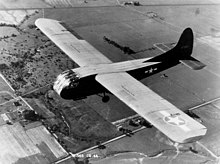
Back Vojenský kluzák Czech Lastensegler German Planeador militar Spanish بادپر نظامی Persian Sotilasliitokoneet Finnish Planeur militaire French 軍用グライダー Japanese Glider tentera Malay Militære glidefly NB Szybowiec wojskowy Polish

Military gliders (an offshoot of common gliders) have been used by the militaries of various countries for carrying troops (glider infantry) and heavy equipment to a combat zone, mainly during the Second World War. These engineless aircraft were towed into the air and most of the way to their target by military transport planes, e.g., C-47 Skytrain or Dakota, or bombers relegated to secondary activities, e.g., Short Stirling. Most military gliders do not soar, although there were attempts to build military sailplanes as well, such as the DFS 228.
Once released from the tow craft near the front, they were to land on any convenient open terrain close to the target, hopefully with as little damage to the cargo and crew as possible, as most landing zones (LZ) were far from ideal. The one-way nature of the missions meant that they were treated as semi-expendable leading to construction from common and inexpensive materials such as wood. Most nations seriously attempted to recover as many as possible, to re-use them, so they were not originally intended to be disposable, although resource-rich nations like the US sometimes used them as if they were, since it was easier than recovering them.[citation needed]
Troops landing by glider were referred to as air-landing as opposed to paratroops. Landing by parachute caused the troops to be spread over a large drop-zone and separated from other airdropped equipment, such as vehicles and anti-tank guns. Gliders, on the other hand, could land troops and ancillaries in greater concentrations precisely at the target landing area. Furthermore, the glider, once released at some distance from the actual target, was effectively silent and difficult for the enemy to identify. Larger gliders were developed to land heavy equipment like anti-tank guns, anti-aircraft guns, small vehicles, such as jeeps, and also light tanks (e.g., the Tetrarch tank). This heavier equipment made otherwise lightly armed paratroop forces a much more capable force. The Soviets also experimented with ways to deliver light tanks by air, including the Antonov A-40, a gliding tank with detachable wings.
By the time of the Korean War, helicopters had largely replaced gliders. Helicopters have the advantage of being able to extract soldiers, in addition to delivering them to the battlefield with more precision. Also, advances in powered transport aircraft had been made, to the extent that even light tanks could be dropped by parachute. And after the widespread use of radar in the military, silence in the air is no longer sufficient for concealment.
© MMXXIII Rich X Search. We shall prevail. All rights reserved. Rich X Search